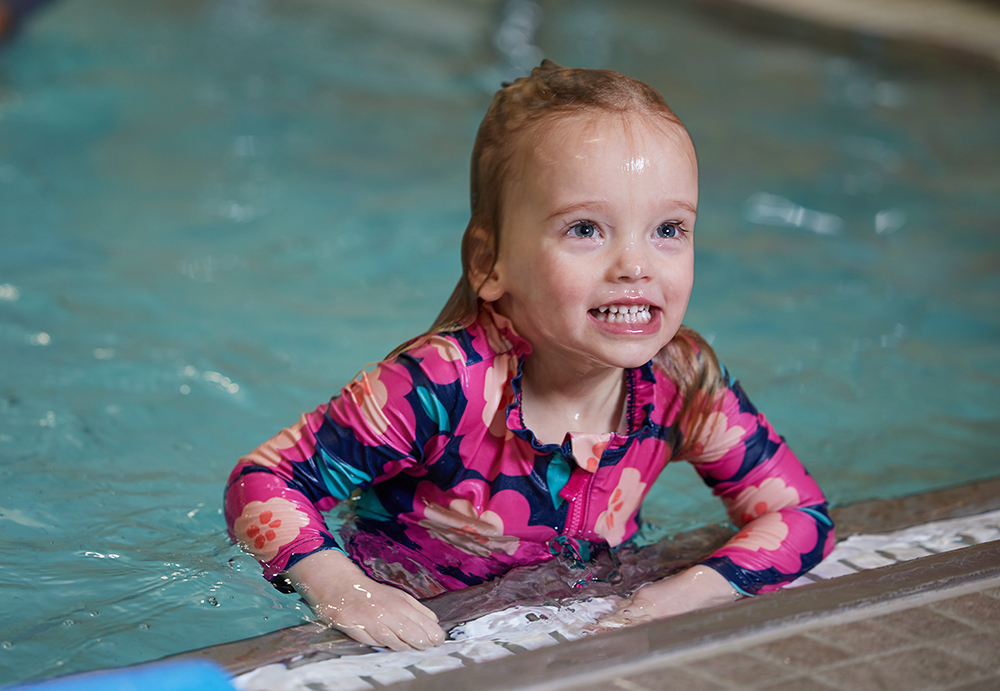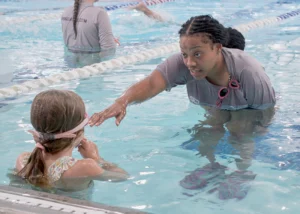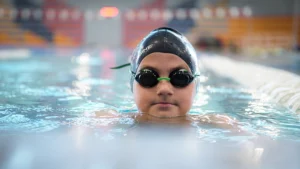When Can Babies Go Swimming for the First Time?
The number one reason to enroll your child in ISR (Infant Swimming Resource™) classes is water safety. Drowning is the leading cause of accidental death in young children, but formal infant swimming lessons can reduce the risk by up to 88%.
WeAquatics’ primary focus is teaching survival swim skills that can save lives in emergencies.

In our Infant Swimming Resource™ (ISR) classes for ages six months to 4 years, our certified instructors teach essential skills such as:
- Breath control and submersion
- Floating and regaining a safe position
- Rolling from front to back
- Swimming to safety
When little ones master these essential survival skills, they gain muscle memory and confidence to navigate the water safely. Let’s walk through the ISR journey to set realistic expectations and highlight the important milestones your child will achieve.
When Can Babies Go Swimming for the First Time?
ISR lessons are designed for children from six months to 4 years of age. By six months, most infants have developed the necessary neck and core strength to begin learning water survival skills. At WeAquatics, our certified instructors teach essential skills including breath control, floating, rolling from front to back, and swimming to safety.
Understanding ISR’s Purpose
What is ISR’s purpose? Unlike traditional swim programs that focus on stroke development or other infant swimming lessons that give little ones an opportunity to play in the water, ISR primarily teaches water survival skills.
David Worrell, founder of WeAquatics, explains, “The disconnect comes in when parents don’t know what survival skills look like. In some cases, they’re looking for it to be more like a traditional technique, like an actual stroke. But that’s not the basis of the ISR lessons, it’s more to do with survival instincts, and those don’t necessarily have a technique that you see in a traditional swimming stroke.”
These survival movements are sequenced specifically to help children roll over, float, and potentially reach safety.
Age Appropriate Skills and Timelines
ISR lessons are typically estimated to take 5-7 weeks, with 10-minute sessions five days a week. However, this timeline can vary based on the child’s age, development, and individual learning pace.
6-15 Months: Roll-Back-to-Float
For infants, the primary skill taught is the roll-back-to-float technique. In this age group, children learn to “roll over and float on their back and wait until someone comes to their aid,” as David describes. This critical skill enables a child who accidentally falls into water to roll onto their back, float, and wait for assistance.
Timeline: Usually 4-6 weeks
Key Milestone: Independent back floating without assistance
15+ Months: Swim-Float-Swim
For toddlers and older children, the program teaches a more advanced sequence called swim-float-swim.
David explains this as “the sequence of swimming, face down, rolling onto your back to rest and breathe, and then resuming face down swimming… as many times as it takes to get to safety.”
The progression is age-appropriate, with younger children typically completing fewer sequences before stopping to wait for assistance in a float position.
As children get older and stronger, they can complete more sequences and cover longer distances.
What They Learn: Swimming face-down, rolling to their back to float and breathe, then resuming face-down swimming
Timeline: Typically 5-7 weeks
Key Milestone: Completing multiple swim-float-swim sequences to reach safety
Week-by-Week Progression
While every child progresses at their own pace, here’s a general outline of what you might expect:
Weeks 1-2: Building Trust and Basic Skills
- Becoming comfortable with the instructor
- Learning breath control
- Initial floating attempts with support
- Rotation skills introduced
Weeks 3-4: Developing Core Skills
- Longer independent floating periods
- Focus on rolling from front to back (younger children)
- Beginning swim movements (older children)
- Decreased resistance to lessons
Weeks 5-7: Refining and Integrating Skills
- Independent back floating
- Complete roll-back-to-float (younger children)
- Swim-float-swim sequences (older children)
- Testing skills in different scenarios
Understanding Children’s Communication
One aspect of ISR that concerns parents is seeing their child cry during lessons. What we must remember is that, especially for our youngest students, crying is their main form of communication.
“The breathing aspect lets us know what frame of mind the student is in,” David explains. Instructors observe how a child cries to assess whether they’re comfortable with the skills being taught. Erratic, uncontrolled crying suggests a child needs more time to get comfortable, while more controlled crying often indicates they’re making progress.
Instructors use this communication to gauge:
- The child’s comfort level with skills
- Their breathing patterns while floating
- Whether they’re progressing appropriately
Rather than viewing crying negatively, understand that it’s part of how young children communicate during this learning process.
Subtle Progress Indicators
Parents might miss some important signs of progress that instructors are trained to recognize.
David points out that body language is a key indicator: “If a student was trying to scramble to get away in the first week of lessons, and still crying, but as time goes on, they are being picked up and just being held and not moving, but crying, that body language suggests that they are getting comfortable.”
Another important sign is how children move in the water: “Less kicking during floating means that the child is relaxing. They’re aware that kicking might splash more water in their face. So when they slow down on stuff like that, they are mastering the skills.”
Watch for these subtle indicators:
Body language changes: Less scrambling and more willingness to be held during rest periods
Reduced kicking during floating: Shows relaxation and skill development
Controlled breathing: Even while upset, managed breathing indicates progress
Predictable responses: Showing awareness of what’s expected
Final Skills Assessment
The final skills assessment is designed to test your child’s abilities in a realistic situation. “The ISR student will test out fully clothed,” David explains. This simulates accidentally falling into water when not prepared for swimming.
During this assessment, instructors create various realistic scenarios to ensure children can handle different challenges. They might make waves while the student is floating to simulate currents or moving water or have the child drift within arms reach of pool walls or lane lines while floating to see that these distractions don’t cause panic.
Maintaining Skills After Graduation
For ongoing practice, David recommends: “It’s good to practice one or two sequences when you get to the pool and then one or two when you’re leaving the pool, but don’t make it all about work or practice during fun/playtime at the pool with your child.” Remember, we don’t want children to feel fatigued— the water should be a joyful experience, so let them play!
He emphasizes that maintenance is crucial as children grow: “Once the student has moved up a size in clothing since their last time in the pool, their muscles and body have changed significantly enough to require a refresher to recalibrate the student to their new size.”
For ongoing water safety:
Enroll in maintenance lessons: Once-weekly 10-minute sessions continue skill development
Practice appropriately: Brief practice at the beginning and end of swim time
Allow for play: Don’t make every pool visit about practicing skills
Consider year-round swimming: Skills are best maintained through regular practice
Every child’s ISR experience is unique. David shares a powerful story about a student who experienced extreme anxiety:
“Thomas (age 2-3) used to come to the pool, and as soon as he got to the pool in his school uniform, before they had a chance to change him into his swimsuit, Thomas was throwing up, and he wasn’t crying or anything like that. He would just be so overwhelmed that he would be withdrawn. And this thing happened for weeks.”
Through patient, consistent instruction, even the most anxious children can progress:
“Over time, making the lesson predictable for him is what slowed that reaction out of him down completely until he wasn’t doing that, but it took me to recognize, okay, let’s go very, very slow. And every lesson has to be 100% predictable for him not to be anxious.”
David emphasizes the importance of customizing the approach for each child because they learn at their own pace.
Communication is Key
We encourage an open, daily dialogue with your child’s instructor to get the most out of ISR classes.
- Ask questions during lessons
- Express concerns directly
- Seek clarification about techniques or progress
- Trust the expertise of certified instructors
Open and honest communication creates a successful partnership between parents, children, and instructors, leading to the best possible outcomes.
Ready to Begin Infant Swimming with ISR?
ISR provides essential water survival skills that could one day save your child’s life. Having these realistic expectations and understanding of the milestones, you can support your little one through this important experience.
Connect with WeAquatics today to discover a time and location in the DMV area that works for your family.




